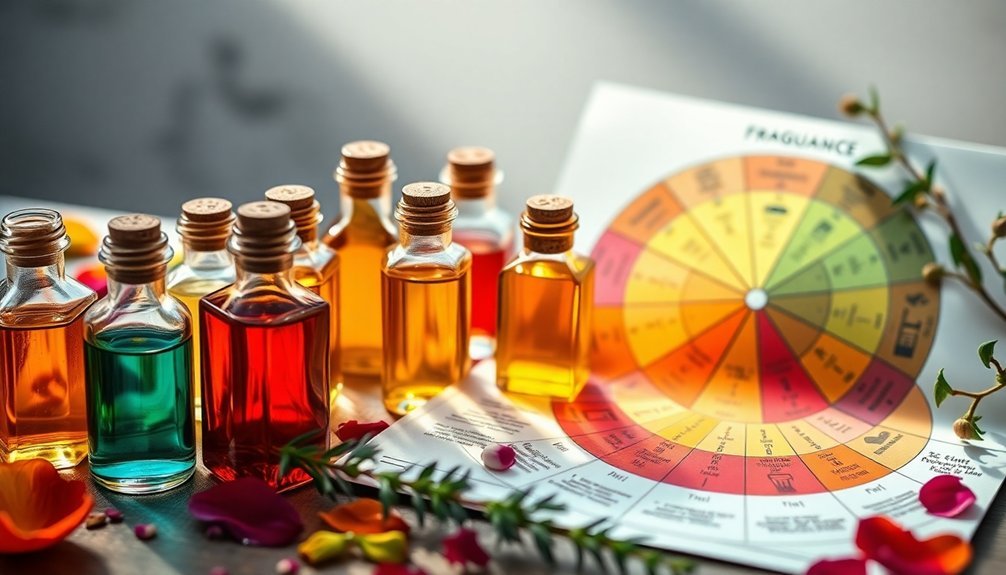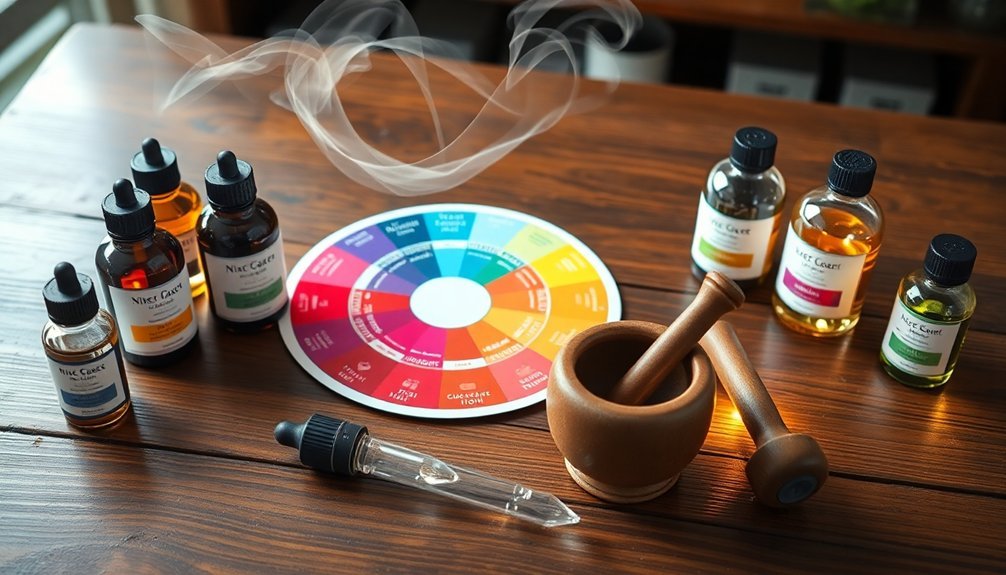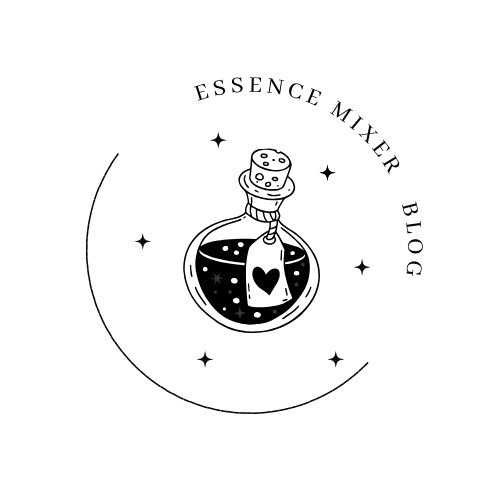To create custom perfume blends, you'll work with four main scent families on the fragrance wheel: Floral, Amber, Woody, and Fresh. Start by selecting complementary notes from these categories, following the standard ratio of 30% top notes, 50% middle notes, and 20% base notes. Use essential tools like a precision scale, pipettes, and blending bottles to measure and mix your fragrances accurately. Understanding these foundational concepts will reveal countless possibilities for crafting your signature scent.
Understanding Basic Scent Categories and Families

When diving into the world of custom perfume creation, understanding the fragrance wheel's four main categories serves as your essential foundation.
The fragrance wheel divides scent families into Floral, Amber, Woody, and Fresh categories, each offering distinct characteristics for your perfume's base notes and top note combinations.
You'll find floral scents capturing the essence of blooms like jasmine and rose, while amber fragrances deliver warm, sweet vanilla notes with spicy undertones.
Woody scents bring earthy depth through sandalwood and cedar, often pairing beautifully with floral elements.
Fresh categories round out the wheel with invigorating citrus, oceanic, and herbal notes that create clean, energizing effects.
Essential Tools for Fragrance Blending
The right tools can make or break your journey into custom perfume creation.
You'll need a precision scale to measure your ingredients accurately, ensuring your formulations remain consistent every time you blend. A dedicated blending bottle allows you to experiment with different combinations while making adjustments to perfect your signature scent.
Keep a fragrance notebook handy to document your creative process – you'll want to record the proportions, ingredients, and your sensory observations for future reference.
Don't forget to use scent strips to evaluate how your fragrance develops over time. A pipette is essential for transferring small amounts of oils precisely, helping you achieve the perfect balance between top, middle, and base notes.
With these tools at your disposal, you're ready to start creating unique fragrance combinations.
The Science Behind Scent Combinations

Understanding scent combinations requires diving into the fascinating world of your olfactory system – a complex network that can distinguish thousands of unique aromas.
When you're creating custom perfumes, you'll work with two main types of scent relationships: kindred notes that share similar qualities, and complementary notes that contrast yet harmonize beautifully.
The fragrance wheel helps you navigate different scent families, from Floral to Woody, each triggering specific emotional responses.
You'll need to carefully balance your composition with quick-evaporating top notes, followed by your middle note heart, and grounding base note foundations.
The key to successful blending lies in understanding how quickly different ingredients evaporate, allowing you to create well-structured fragrances that unfold gracefully over time.
Step-by-Step Mixing Calculations
Creating your perfect custom fragrance starts with precise mathematical calculations to guarantee consistent, reproducible results. You'll need to understand how fragrance wheels work to properly balance your top notes, middle notes, and base notes. Start with the standard 30-50-20 ratio, then convert these percentages into actual measurements.
| Note Type | Percentage | Amount (100ml) |
|---|---|---|
| Top Notes | 30% | 30ml |
| Middle Notes | 50% | 50ml |
| Base Notes | 20% | 20ml |
| Total | 100% | 100ml |
To calculate your measurements, multiply your total desired volume by each note's percentage. For example, if you're making 50ml of perfume, you'll need 15ml of top notes, 25ml of middle notes, and 10ml of base notes. Always record your measurements precisely to replicate successful blends in the future.
Common Blending Ratios and Proportions

Successful perfume blending relies on proven ratios that serve as reliable starting points for your custom fragrances.
The most common blending ratios start with 30% top notes, 50% middle notes, and 20% base notes to create a well-balanced scent. You'll want to test your fragrance combinations using small 1-2 ml batches before scaling up.
- Create intense perfumes by increasing base notes to 25-30% while reducing top notes
- Blend together kindred notes in 1:1 ratios for harmonious results
- Use 1:2 ratios when working with complementary notes for complexity
- Consider evaporation rates, as top notes fade faster than base notes
Remember that these ratios serve as guidelines rather than strict rules. You can adjust the proportions based on your desired fragrance profile and the specific characteristics of your chosen notes.
Fragrance Notes and Their Compatibility
When you're crafting custom perfumes, the art of pairing fragrance notes can make or break your blend. Understanding how different scent families interact will help you create harmonious combinations that evolve beautifully on your skin.
Start by identifying compatible notes within adjacent scent families – these naturally complement each other and create smooth transitions. For unexpected depth, try pairing opposite families to create intriguing contrasts.
Remember that base notes anchor your creation, so choose these carefully to support your blend's overall character.
As you experiment, pay attention to how the notes unfold over time. Your top notes will fade first, revealing middle notes that bridge to your lasting base notes.
The key is finding the right balance between these layers while ensuring all chosen fragrances work together in perfect harmony.
Advanced Blending Techniques and Tips

Armed with knowledge of fragrance compatibility, you're ready to explore sophisticated blending methods. The fragrance wheel serves as your guide for identifying complementary notes that'll create harmonious combinations.
Start with a strong base note, then strategically layer lighter scents to build your unique fragrance profile. Keep your initial experiments simple, working with fewer notes until you've mastered basic layering techniques.
- Document each combination you try, noting which ratios work best
- Test opposite positions on the fragrance wheel for unexpected yet pleasing matches
- Begin with minimal drops of each scent to avoid overwhelming combinations
- Allow each layer to settle before adding the next note
As you develop your blending skills, you'll discover that creating custom perfumes is both an art and a science, requiring patience and methodical experimentation to achieve the perfect balance.
Frequently Asked Questions
How to Create Your Own Fragrance Blend?
Start with your preferred scent family, blend top, middle, and base notes using droppers. Mix complementary or similar fragrances, test small amounts, and let your creation age for balanced results.
How Do I Make My Own Roll on Perfume?
You'll need a roll-on bottle, base oil like jojoba, and essential oils. Mix 15-30 drops of your chosen scents with the base oil, leaving space for blending. Let it sit for 48 hours before use.
What Is the Ratio for Blending Perfume?
You'll want to follow the standard 30-50-20 perfume ratio: use 30% top notes, 50% middle notes, and 20% base notes. You can adjust these percentages slightly based on your desired fragrance intensity.
What Is the Fragrance Wheel Theory?
The fragrance wheel theory helps you understand how scents relate to each other. You'll find four main families: Floral, Amber, Woody, and Fresh, with subfamilies arranged in a circular pattern showing complementary relationships.
In Summary
You've now mastered the basics of creating custom perfume blends using the fragrance wheel. Don't be afraid to experiment with different combinations while following the ratios you've learned. Start with simple two-note blends and work your way up to more complex formulations. Keep detailed notes of your successes and failures. With practice and patience, you'll develop your own signature scents that perfectly express your creative vision.





Leave a Reply